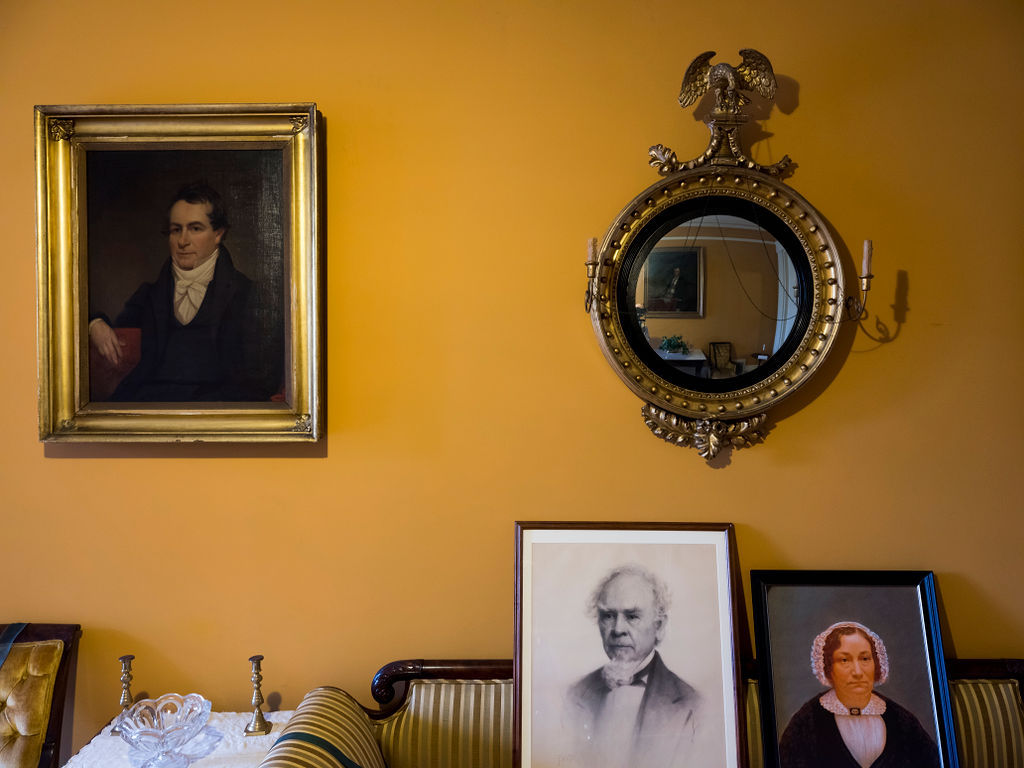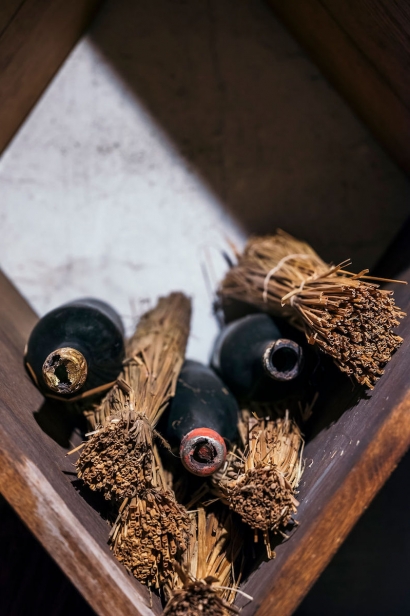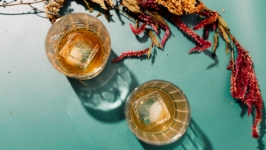Ten Broeck Mansion's Secret Treasure
Feminist theater, a non-profit facing a financial crunch. Slaveholders, prohibition, buried treasure.
No, it’s not the disparate elements of Ryan Murphy’s next improbable, incongruous megahit, it’s the weird cocktail of intrigue and history that comprises Ten Broeck Mansion, and its newly minted Wine Club.
Let’s back up. Ten Broeck Mansion, a historical museum and non-profit organization run by the Albany Historical County Association since 1948, was first built in 1797 for General Abraham Ten Broeck and his wife, Elizabeth Van Rensselaer, after a fire destroyed their previous home. Ten Broeck erected a Federal-style house on five acres of land leased from his brother-in-law, the patroon of (what was then) Watervliet, Stephen Van Rensselaer. It featured a sloping lawn, formal gardens and views of the busy Hudson River.
The Ten Broeck family occupied a prominent position in Albany’s high society, having already resided in the U.S. for five generations (in the 18th century!). Ten Broeck served as a delegate to the Second Continental Congress, as a brigadier general commanding the New York Militia in the Battle of Saratoga, as mayor of Albany, a member of the State Senate, president of the Bank of Albany, the first president of the Albany Public Library and a trustee of Union College.
After Ten Broeck and his wife’s death in 1812, the home was sold. After going through a few owners, it was eventually sold to Thomas Worth Olcott in 1848.
The home, which is open to visitors and hosts community and educational events on a regular basis, captures a snapshot of time in Albany. Ten Broeck itself reflects the changing tastes and desires of a culture over a century and a half, boasting original Federalist elements like a capacious and ornate formal dining room for entertaining, plus refurbishments and renovations in Greek Revival style, and Victorian-style additions of second-floor bathrooms and a first-floor butler’s pantry.
Ten Broeck also played a minor role in national politics. Ten Broeck’s son Dirck clerked for Alexander Hamilton and was present at his deathbed in 1804; his father probably read the letter describing his fatal duel with Aaron Burr to his wife in the study. Later, the Olcotts frequently hosted the eighth president, Martin Van Buren, at their home. He likely sampled Bordeaux from the Olcotts’ impressive wine collection, allegedly one of the most renowned in the country at that time.
And then there are the ghosts. “A paranormal group actually meets here monthly,” Samantha Hall-Saladino, the Ten Broeck Mansion’s executive director says, acknowledging the widespread rumors of a woman in white floating ominously (is there any other way for a specter to float?) around the second floor, and the disembodied voice of someone believed to be Thomas Olcott echoing through the home being detected by self-styled experts in these matters.
“It’s easy to get creeped out at night in a home with as much history as Ten Broeck, and while some people believe it’s haunted, others will explain away noises as houses settling,” she says.
Other less romantic historical truths can be confronted as well. Archaeological excavations and research in the past decade have revealed the existence of outbuildings on the grounds that were almost certainly used as summer kitchens and slave quarters.
“About 10 enslaved people served at Ten Broeck over the years, but as you can imagine, documentation of their lives is not prolific,” Hall-Saladino explains. Because Ten Broeck wasn’t a working farm, the slaves’ duties were most likely domestic. When Ten Broeck died in 1810, his widow, Elizabeth, gave at least one slave conditional freedom. (Meaning she had to remain in the area and return to Ten Broeck to help once a week but did not have to live under Elizabeth’s roof, Hall-Saladino explains.)
The legacy of slavery at Ten Broeck is a powerful reminder that the Empire State was once a thriving slave state. Slave ships arrived at the port of New York City, and as many as 5,000 enslaved people lived in Albany County alone before slavery was officially abolished in New York in 1827, Hall-Saladino notes.
We would be significantly less likely to have access to this time capsule, however, if it weren’t for the discovery of a hidden room filled with exceedingly rare, extraordinarily valuable, primarily French, wine.
After the ACHA took over the property in 1948, Ten Broeck struggled to find a foothold in the populous landscape of historical museums in upstate New York. Yes, it offered an important and rare glimpse into our region’s socio-political history and mode of living, but it wasn’t the scene of a major duel, tragedy or epidemic, and no one truly famous ever lived there. So it failed to attract the passionate and consistent financial patronage of the general populace or corporate sponsors.
By the 1970s, it was barely afloat, Hall-Saladino explains. And then, a worker doing repairs alerted the ACHA to a jammed door in the cellar. The association’s president, James M. Flavin, now deceased, was the one who opened the door, Hall-Saladino says.
Inside, he discovered 30 cases of rare wines. He knew enough to know he and the rest of the association didn’t know enough to properly assess them. They brought in the late, great wine expert—once described as “an archaeologist with a corkscrew”—Alexander “Sandy” McNally to check it out.
The findings sent him into the kind of ecstatic raptures only sommeliers and 18th-century poets attempt to express with a straight face.
As he told People magazine at the time: “With my heart beating as if I were entering King Tut’s tomb, I discovered hundreds of rare French wines, many of them dating from the late 1800s.”
It was great for the mansion, too. The collection included rarities that would have been valuable even when they were bottled, such as Chambertin 1875, Chateau Lafite Rothschild 1869 and 1870, Chateau Mouton-Rothschild 1875, 1878 and 1887, and Chateau d’Yquem 1869, considered the best wine of Sauternes. The association agreed to sell the 200 drinkable wines and use the funds to balance the mansion’s books.
The room was secreted, Hall-Saladino guesses, due to ye olde bugaboo, Prohibition. One of history’s greatest buzz-kills descended like a wet blanket over the entire country, and while it was technically legal to consume wine one already possessed after Prohibition, many committed collectors also chose to hide their most cherished bottles. The truth is, though, no one really knows why the wine was hidden for so long, she says.
“It’s kind of a mystery,” Hall-Saladino acknowledges. “The last family member who inherited the home didn’t spend any time here, so by the time it was sold to the association, that connection to the home and its contents had been lost.”
On May 25, 1977, the wines were first auctioned off through Heublein Inc. in Atlanta. Through that auction and other sales, the bottles ultimately brought in about $100,000. The association received 75% of the proceeds from sales, all of which went into restoration work and programming.
But perhaps more importantly, the existence of the room and the national coverage of the auction itself was just the spark of intrigue and sass the mansion needed to keep it relevant, and attract new blood, in the form of visitors (admit it, you may not have ever ventured off to see a cookie-cutter historical home, but this one sounds pretty intriguing, right?) and talent.
“My colleague Dr. Jennifer Dorsey was president of the board when she invited me to come by,” Krysta Dennis, PhD, a lecturer in creative arts at Siena College and a wine expert, says. (Dr. Dorsey’s term just ended, and now Paula Hemmings is serving as president.) “I wrote a play called Votes for Women that she invited me to stage there. While I was working on the performance, I fell in love with the space, especially the wine cellar when I was there. I thought it was crazy that here was one of the oldest wine cellars in America, with such a fascinating history, why wasn’t it being used for events, why wasn’t it being highlighted?”
Dennis, who previously ran wine clubs in London, persuaded the board into holding a wine club in the cellar of the mansion four times a year. Seasonal wines will be tasted and paired with small nibbles. The inaugural meeting occurred on March 29, 2018. Every event since has sold out; the next will be held December 27, and as of press time, there were a few slots available.
Some of the roughly 172 wines deemed undrinkable due to spoilage remain and serve as a visual backdrop of the club. But more importantly, it’s an opportunity for regional wine and history geeks to get together and chat.
“We did not want it to be fusty, and while a wine expert leads it, everyone ends up talking and getting to know each other,” she says. Dennis led the fi st club meeting, and subsequent wine clubs were led by sommeliers and wine experts Beth Doris, Kristoph DiMaria and Shane Sczepankowski. The wine club is collaborating with Mark Brogna of Capital Wine & Spirits on Lark Street in Albany.
“Right now our focus is seasonal wines, but we’d also like to tackle tastings by region, varietal and style, and we also try to throw in a few blind tastes here and there to have participants make guesses as to what they’re tasting,” she says. Participants are also given an opportunity to examine some of the old wine bottles, and if they try something they like, Brogna will off er them a case discount at his store to members of the wine club.
Chasing a favorite vice with a draught of history and then scoring a deal on a case, all done while in a pretty 18th-century cellar that may or may not be haunted, sounds delightful and intriguing, with a bracing dash of scary.
Ten Broeck Mansion | @tenbroeckmansion
Albany Historical County Association
Capital Wine & Spirits








